
CSA C22.2 NO. 208-14
- Comments Off on CSA C22.2 NO. 208-14
- CSA
Preface
This is the third edition of CSA C22.2 No. 208, Fire Alarm and Signal Cable. It supersedes the previous editions published in 2003 and 1986. It is one of a series of Standards issued under Part II of the Canadian Electrical Code. This Standard covers the cable types used for installing fire alarm equipment in buildings and other structures. The main changes in this edition are as follows: a) inclusion of type FAS 150; b) elimination of lead-coated copper wires; c) inclusion of an alternative dielectric strength test; d) inclusion of armour tests; and e) inclusion of requirements for limited smoke cable, i.e., cable that meets the flame test classification FT4-ST1. For general information on the Standards of the Canadian Electrical Code, Part II, see the Preface of CAN/CSA-C22.2 No. 0-10, General Requirements – Canadian Electrical Code, Part II.
Scope
1.1 This Standard applies to single- and multiple-conductor fire alarm and signal cables with a maximum nominal voltage rating of 300 V and a minimum temperature rating of 60 ° C for use in buildings and other structures in dry or damp locations in accordance with the Rules of Sections 16 and 32 of the Canadian Electrical Code, Part I. 1.2 Because other CSA Group Standards specify requirements for certain constructions suitable for use as fire alarm and signal cable, this Standard does not cover all such constructions. 1.3 The designations for constructions covered by this Standard use the letters FAS followed, for constructions rated above 60 °C, by the temperature rating. The type designations are as follows: a) FAS; b) FAS 90; c) FAS 105; d) FAS 150; and e) FAS 200. 1.4 In this Standard, “shall” is used to express a requirement, i.e., a provision that the user is obliged to satisfy in order to comply with the standard; “should” is used to express a recommendation or that which is advised but not required; and “may” is used to express an option or that which is permissible within the limits of the standard. Notes accompanying clauses do not include requirements or alternative requirements; the purpose of a note accompanying a clause is to separate from the text explanatory or informative material. Notes to tables and figures are considered part of the table or figure and may be written as requirements. Annexes are designated normative (mandatory) or informative (nonmandatory) to define their application.
Product Details
- Edition:
- 3rd
- Published:
- 07/01/2014
- ISBN(s):
- 9781771396363
- Number of Pages:
- 36
- File Size:
- 1 file , 530 KB
- Product Code(s):
- 2423207, 2423207, 2423207



